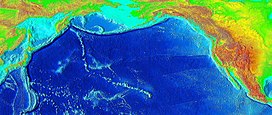Hawaiian-Emperor seamount chain
| Hawaiian-Emperor seamount chain | |
|---|---|
| Hawaiian Islands | |

Mauna Kea, the range's highest point
|
|
| Highest point | |
| Peak | Mauna Kea (Hawaii, United States) |
| Elevation | 4,207 m (13,802 ft) |
| Coordinates | 19°49′14″N 155°28′05″W / 19.82056°N 155.46806°WCoordinates: 19°49′14″N 155°28′05″W / 19.82056°N 155.46806°W |
| Dimensions | |
| Length | 5,800 km (3,600 mi) NE-SW |
| Geography | |
| Country | United States |
| State | Hawaii |
| Geology | |
| Orogeny | Hawaii hotspot |
The Hawaiian–Emperor seamount chain is a mostly undersea mountain range in the Pacific Ocean that reaches above sea level in Hawaii. It is composed of the Hawaiian ridge, consisting of the islands of the Hawaiian chain northwest to Kure Atoll, and the Emperor Seamounts: together they form a vast underwater mountain region of islands and intervening seamounts, atolls, shallows, banks and reefs along a line trending southeast to northwest beneath the northern Pacific Ocean. The seamount chain, containing over 80 identified undersea volcanoes, stretches over 5,800 kilometres (3,600 mi) from the Aleutian Trench in the far northwest Pacific to the Loʻihi seamount, the youngest volcano in the chain, which lies about 35 kilometres (22 mi) southeast of the Island of Hawaiʻi.
The chain can be divided into three subsections. The first, the Hawaiian archipelago (also known as the Windward isles), consists of the islands comprising the U.S. state of Hawaii. As it is the closest to the hotspot, this volcanically active region is the youngest part of the chain, with ages ranging from 400,000 years to 5.1 million years. The island of Hawaiʻi is composed of five volcanoes, of which three (Kilauea, Mauna Loa, and Hualalai) are still active. Lōʻihi Seamount continues to grow offshore, and is the only known volcano in the chain in the submarine pre-shield stage.
The second part of the chain is composed of the Northwestern Hawaiian Islands, collectively referred to as the Leeward isles, the constituents of which are between 7.2 and 27.7 million years in age. Erosion has long since overtaken volcanic activity at these islands, and most of them are atolls, atoll islands, and extinct islands. They contain many of the most northerly atolls in the world; one of them, Kure Atoll, is the northernmost atoll in the world. On June 15, 2006, U.S. President George W. Bush issued a proclamation creating Papahānaumokuākea Marine National Monument under the Antiquities Act of 1906. The national monument, meant to protect the biodiversity of the Hawaiian isles, encompasses all of the northern isles, and is one of the largest such protected areas in the world. The proclamation limits tourism to the area, and calls for a phase-out of fishing by 2011.
...
Wikipedia

